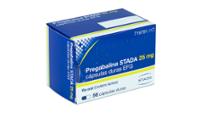

Pregabalina stada 25 mg capsulas duras efg


How to use Pregabalina stada 25 mg capsulas duras efg
Introduction
Leaflet: information for the user
Pregabalina Stada 25 mg hard capsules EFG
Pregabalina Stada 50 mg hard capsules EFG
Pregabalina Stada 75 mg hard capsules EFG
Pregabalina Stada 100 mg hard capsules EFG
Pregabalina Stada 150 mg hard capsules EFG
Pregabalina Stada 200 mg hard capsules EFG
Pregabalina Stada 300 mg hard capsules EFG
Read this leaflet carefully before you start taking this medicine, because it contains important information for you.
- Keep this leaflet, as you may need to read it again.
If you have any questions, ask your doctor or pharmacist.
This medicine has been prescribed for you only, and you must not give it to others even if they have the same symptoms as you, as it may harm them.
If you experience any side effects, consult your doctor or pharmacist, even if they are not listed in this leaflet. See section 4.
6. Contents of the pack and additional information
1. What is Pregabalina Stada and what is it used for
Pregabalina Stada belongs to a group of medications used for the treatment of epilepsy, peripheral and central neuropathic pain, and generalized anxiety disorder (GAD) in adults.
Peripheral and central neuropathic pain:Pregabalina is used for the treatment of chronic pain caused by nerve damage. Various diseases can cause peripheral neuropathic pain, such as diabetes or herpes. The pain sensation could be described as heat, burning, pulsating pain, stabbing pain, acute pain, spasms, continuous pain, tingling, numbness, and pins and needles sensation. Peripheral and central neuropathic pain could also be associated with mood changes, sleep disturbances, fatigue (tiredness), and may affect physical and social activity and overall quality of life.
Epilepsy:Pregabalina is used in the treatment of certain types of epilepsy (partial seizures with or without secondary generalization) in adults. Your doctor will prescribe pregabalina to treat epilepsy when your current treatment does not control the disease. You must take pregabalina in addition to your current treatment. Pregabalina should not be administered alone, but always used in combination with other antiepileptic treatments.
Generalized anxiety disorder:Pregabalina is used in the treatment of generalized anxiety disorder (GAD). Symptoms of GAD include excessive and prolonged anxiety and worry that are difficult to control. GAD can also produce restlessness or feeling of excitement or nervousness, feeling easily fatigued (tired), difficulty concentrating or feeling mentally blank, irritability, muscle tension, or sleep disturbances. This is different from everyday stress and life tensions.
2. What you need to know before starting Pregabalina Stada
- If you are allergic to pregabalin or any of the other ingredients of this medication (listed in section 6).
Warnings and precautions
Consult your doctor or pharmacist before starting to take pregabalin.
- Some patients treated with pregabalin have reported symptoms indicating an allergic reaction. These symptoms include swelling of the face, lips, tongue, and throat, as well as widespread skin rash. If you experience any of these symptoms, you should seek medical attention immediately.
- Severe skin reactions, such as Stevens-Johnson syndrome and toxic epidermal necrolysis, have been associated with pregabalin treatment. Stop taking pregabalin and seek medical attention immediately if you observe any symptoms related to these severe skin reactions described in section 4.
- Pregabalin has been associated with dizziness and somnolence, which could increase the risk of accidental injuries (falls) in elderly patients. Therefore, you should exercise caution until you become familiar with the effects of the medication.
- Pregabalin may cause blurred vision, loss of vision, or other changes in vision, many of which are transient.If you experience any alteration in your vision, you should inform your doctor immediately.
- Patients with diabetes who gain weight while taking pregabalin may need to change their diabetes medications.
- Certain adverse effects, such as somnolence, may be more frequent since patients with spinal cord injury may be taking other medications for treatment, for example, pain or spasticity, with adverse effects similar to those of pregabalin, so the intensity of these effects may increase when taken together.
- Severe heart failure has been reported in some patients treated with pregabalin. Most of them were elderly patients with cardiovascular diseases.Before using this medication, you should inform your doctor if you have a history of heart disease.
- Severe kidney failure has been reported in some patients treated with pregabalin. If during pregabalin treatment you note a decrease in your ability to urinate, you should inform your doctor since discontinuing treatment may improve this situation.
- Some patients taking antiepileptic medications, such as pregabalin, have had thoughts of self-harm or suicide or have shown suicidal behavior.If at any time you experience these thoughts or have shown such behavior, contact your doctor as soon as possible.
- When pregabalin is taken with other medications that can cause constipation (such as certain types of pain medications), it may cause gastrointestinal problems (e.g., constipation and intestinal blockage or paralysis). Inform your doctor if you experience constipation, especially if you are prone to this problem.
- Before taking this medication, inform your doctor if you have ever abused or been dependent on alcohol, prescription medications, or illegal drugs; it may mean you have a higher risk of becoming dependent on pregabalin.
- Severe seizures have been reported during or shortly after pregabalin treatment.If you experience seizures, contact your doctor immediately.
- Severe brain dysfunction (encephalopathy) has been reported in some patients taking pregabalin and having other serious diseases. Inform your doctor if you have a history of any serious disease, including liver or kidney disease.
- Severe breathing difficulties have been reported. If you have nervous system disorders, respiratory disorders, kidney failure, or are over 65 years old, your doctor may prescribe a different dose. Contact your doctor if you experience breathing difficulties or shallow breathing.
Dependence
Some people may become dependent on pregabalin (need to continue taking the medication). They may experience withdrawal effects when they stop using pregabalin (see section 3, “How to take Pregabalina Stada” and “If you stop taking Pregabalina Stada”).If you are concerned that you may become dependent on pregabalin, it is essential to consult your doctor.
If you notice any of the following signs while taking pregabalin, it could be a sign that you have become dependent:
- Necessary to take the medication for a longer period than recommended by your doctor.
- Feels the need to take a higher dose than recommended.
- Uses the medication for reasons other than those prescribed.
- Has made repeated and unsuccessful attempts to stop or control the use of the medication.
- Experiences discomfort when stopping the medication and feels better once the medication is taken again.
If you notice any of these signs, talk to your doctor to analyze the best plan of care for you, including when it is appropriate to stop treatment and how to do it safely.
Children and adolescents
The safety and efficacy of pregabalin have not been established in children and adolescents (under 18 years), so pregabalin should not be used in this age group.
Other medications and Pregabalina Stada
Inform your doctor or pharmacist if you are taking, have taken recently, or may need to take any other medication.
Pregabalin and certain medications may influence each other (interactions). When pregabalin is used with certain medications that have a sedative effect (including opioids), pregabalin may potentiate those effects, and may lead to respiratory failure, coma, and death. The degree of dizziness, somnolence, and decreased concentration may increase if pregabalin is taken with other medications that contain:
- Oxycodone - (used as an analgesic)
- Lorazepam - (used to treat anxiety)
- Alcohol
Pregabalin can be taken with oral contraceptives.
Taking Pregabalina Stada with food, drinks, and alcohol
Pregabalin capsules can be taken with or without food.
It is recommended not to take alcohol during pregabalin treatment.
Pregnancy and breastfeeding
You should not take pregabalin during pregnancy or lactation, unless your doctor has told you to. Using pregabalin during the first 3 months of pregnancy may cause congenital anomalies in the fetus that require medical treatment. In a study reviewing data from women in Nordic countries who took pregabalin during the first 3 months of pregnancy, 6 out of 100 babies had such congenital anomalies. This contrasts with 4 out of 100 babies born to women not treated with pregabalin in the study. Congenital anomalies of the face (cleft palate), eyes, nervous system (including the brain), kidneys, and genitals have been reported.
A reliable contraceptive method should be used in women of childbearing age. If you are pregnant or breastfeeding, believe you may be pregnant, or intend to become pregnant, consult your doctor or pharmacist before using this medication.
Driving and operating machinery
Pregabalin may cause dizziness, somnolence, and decreased concentration. You should not drive, operate heavy machinery, or engage in other potentially hazardous activities until you know if this medication affects your ability to perform these activities.
Pregabalina Stada contains lactose
If your doctor has told you that you have an intolerance to certain sugars, consult with him before taking this medication.
3. How to Take Pregabalina Stada
Follow exactly the administration instructions of this medication indicated by your doctor. In case of doubt, consult your doctor or pharmacist again. Do not take more medication than prescribed.
Dosage
Your doctor will determine the appropriate dose for you.
Peripheral and central neuropathic pain, epilepsy, or generalized anxiety disorder:
- Take the number of capsules indicated by your doctor.
- The dose, adjusted for you and your condition, will generally be between 150 mg and 600 mg per day.
- Your doctor will tell you to take pregabalin two or three times a day. In the case of twice a day, take pregabalin once in the morning and once at night, approximately at the same time every day. In the case of three times a day, take pregabalin in the morning, at noon, and at night, approximately at the same time every day.
If you estimate that the action of pregabalin is too strong or too weak, inform your doctor or pharmacist.
Elderly patients
If you are an elderly patient (over 65 years old), take pregabalin normally, except if you have kidney problems.
Patients with kidney problems
Your doctor may prescribe a different dosing regimen and/or dose if you have kidney problems.
Administration form
Pregabalin is exclusively for oral use.
Swallow the capsule whole with water.
Treatment duration
Continue taking pregabalin until your doctor tells you to stop.
If you take more Pregabalina Stada than you should
Call your doctor or go to the nearest emergency service immediately. Bring the pregabalin package with you. As a result of taking more pregabalin than you should, you may feel drowsy, confused, agitated, or restless. Seizures and loss of consciousness (coma) have also been reported.
If you forgot to take Pregabalina Stada
It is essential to take the pregabalin capsules regularly at the same time every day. If you forget to take a dose, take it as soon as you remember, unless it is time for the next dose. In that case, continue with the next dose normally. Do not take a double dose to compensate for the missed doses.
If you interrupt the treatment with Pregabalina Stada
Do not stop taking pregabalin suddenly. If you want to stop taking pregabalin, talk to your doctor first. He will tell you how to do it. If you are going to stop treatment, this should be done gradually over a minimum of one week.
Once the short- or long-term treatment with pregabalin is completed, you should know that you may experience certain adverse effects, called withdrawal effects. These effects include insomnia, headaches, nausea, anxiety, diarrhea, flu-like symptoms, seizures, nervousness, depression, thoughts of self-harm or suicide, pain, sweating, and dizziness. These symptoms may appear more frequently or severely if you have been taking pregabalin for a longer period. If you experience withdrawal effects, see your doctor.
If you have any other doubts about the use of this medication, ask your doctor or pharmacist.
4. Possible Adverse Effects
Like all medications, this medication may cause side effects, although not everyone will experience them.
If you experience swelling in the face or tongue, or if your skin becomes red and forms blisters or peels, you should seek immediate medical attention.
Very common (may affect more than 1 in 10 people):
- Dizziness, drowsiness, headache
Common (may affect up to 1 in 10 people):
- Increased appetite
- Sensation of euphoria, confusion, disorientation, decreased libido, irritability
- Alteration of attention, clumsiness of movement, deterioration of memory, loss of memory, tremors, difficulty speaking, sensation of numbness, tingling, sedation, lethargy, insomnia, fatigue, abnormal sensation
- Blurred vision, double vision
- Dizziness, balance problems, falls
- Dry mouth, constipation, vomiting, flatulence, diarrhea, nausea, swollen abdomen
- Difficulty achieving erection
- Swelling of the body including extremities
- Sensation of intoxication, alterations in gait
- Weight gain
- Muscle cramps, joint pain, back pain, pain in extremities
- Sore throat
Uncommon (may affect up to 1 in 100 people):
- Loss of appetite, weight loss, low blood sugar, high blood sugar
- Change in self-perception, restlessness, depression, agitation, mood changes, difficulty finding words, hallucinations, strange dreams, anxiety attacks, apathy, aggression, elevated mood, mental deterioration, difficulty thinking, increased libido, sexual dysfunction including inability to achieve orgasm, delayed ejaculation
- Changes in vision, abnormal eye movements, changes in vision including tunnel vision, flashes of light, spasmodic movements, decreased reflexes, hyperactivity, dizziness on standing, sensitive skin, loss of taste, sensation of burning, tremors on movement, decreased consciousness, loss of consciousness, fainting, increased sensitivity to sounds, general discomfort
- Dry eyes, swollen eyes, eye pain, tired eyes, watery eyes, eye irritation
- Alterations in heart rhythm, increased heart rate, low blood pressure, high blood pressure, changes in heart rhythm, heart failure
- Flushes, hot flashes
- Difficulty breathing, dry nose, nasal congestion
- Increased saliva production, burning, numbness around the mouth
- Sweating, rash, chills, fever
- Muscle spasms, joint swelling, muscle stiffness, pain including muscle pain, neck pain
- Breast pain
- Difficulty or pain urinating, inability to hold urine
- Weakness, thirst, chest oppression
- Changes in blood test results and liver function tests (elevated creatine phosphokinase in blood, elevated alanine aminotransferase, elevated aspartate aminotransferase, decreased platelet count, neutropenia, elevated creatinine in blood, decreased potassium in blood)
- Allergic reactions that may include difficulty breathing, eye inflammation (keratitis), and a severe skin reaction characterized byflat, red patches, often with central blisters, skin peeling, mouth ulcers, throat, nasal, genital, and eye ulcers. These severe skin reactions may be preceded by fever and flu-like symptoms (Stevens-Johnson syndrome, toxic epidermal necrolysis).
- Jaundice (yellowing of the skin and eyes).
- Parkinsonism, symptoms similar to Parkinson's disease; such as tremors, bradykinesia (decreased ability to move), and rigidity (muscle stiffness).
Rare (may affect up to 1 in 1,000 people):
- Altered sense of smell, oscillating vision, alteration of depth perception, visual brightness, loss of vision
- Dilated pupils, strabismus
- Cold sweat, throat constriction, swollen tongue
- Pancreatitis (inflammation of the pancreas)
- Difficulty swallowing
- Slowed or reduced body movement
- Difficulty writing correctly
- Fluid accumulation in the abdominal area
- Pulmonary edema
- Seizures
- Changes in the electrocardiogram (ECG) corresponding to alterations in heart rhythm
- Muscle damage
- Milk secretion, abnormal breast growth, increased breast size in men
- Menstrual period interruption
- Renal insufficiency, reduced urine output, urinary retention
- Decreased white blood cell count
- Inappropriate behavior, suicidal behavior, suicidal thoughts
- Allergic reactions that may include difficulty breathing, eye inflammation (keratitis), and a severe skin reaction characterized byflat, red patches, often with central blisters, skin peeling, mouth ulcers, throat, nasal, genital, and eye ulcers. These severe skin reactions may be preceded by fever and flu-like symptoms (Stevens-Johnson syndrome, toxic epidermal necrolysis).
- Jaundice (yellowing of the skin and eyes).
- Parkinsonism, symptoms similar to Parkinson's disease; such as tremors, bradykinesia (decreased ability to move), and rigidity (muscle stiffness).
Very rare (may affect up to 1 in 10,000 people):
- Liver insufficiency
- Hepatitis (inflammation of the liver).
Frequency not known (cannot be estimated from available data):
•Becoming dependent on pregabalin ("drug dependence").
Once a short- or long-term treatment with pregabalin is completed, you should know that you may experience certain side effects, called withdrawal effects (see "If you stop taking Pregabalin Stada").
Certain side effects, such as drowsiness, may be more frequent since patients with spinal cord injury may be taking other medications to treat, for example, pain or spasticity, with side effects similar to those of pregabalin, so the intensity of these side effects may increase when taken together.
A post-marketing adverse reaction has been reported: difficulty breathing, shallow breathing.
Reporting of side effects
If you experience any type of side effect, consult your doctor or pharmacist, even if it is a possible side effect that does not appear in this leaflet. You can also report them directly through the Spanish System for the Vigilance of Medicinal Products for Human Use:https://www.notificaram.es. By reporting side effects, you can contribute to providing more information on the safety of this medication.
5. Conservation of Pregabalina Stada
Keep this medication out of the sight and reach of children.
Do not use this medication after the expiration date that appears on the packaging and blister after CAD. The expiration date is the last day of the month indicated.
This medication does not require special conditions for conservation.
Medications should not be disposed of through drains or in the trash. Dispose of the packaging and medications you no longer need at the SIGRE collection point of the pharmacy. Ask your pharmacist how to dispose of the packaging and medications you no longer need. This will help protect the environment.
6. Contents of the packaging and additional information
Composition of Pregabalina Stada
The active ingredient is pregabalina.
Pregabalina Stada 25 mg: Each hard capsule contains 25 mg of pregabalina.
Pregabalina Stada 50 mg: Each hard capsule contains 50 mg of pregabalina.
Pregabalina Stada 75 mg: Each hard capsule contains 75 mg of pregabalina.
Pregabalina Stada 100 mg: Each hard capsule contains 100 mg of pregabalina.
Pregabalina Stada 150 mg: Each hard capsule contains 150 mg of pregabalina.
Pregabalina Stada 200 mg: Each hard capsule contains 200 mg of pregabalina.
Pregabalina Stada 300 mg: Each hard capsule contains 300 mg of pregabalina.
The other components are:
Pregabalina Stada 25 mg: Lactose monohydrate, pregelatinized starch (from corn), talc, gelatin, and titanium dioxide (E-171).
Pregabalina Stada 50 mg: Lactose monohydrate, pregelatinized starch (from corn), talc, gelatin, titanium dioxide (E-171), shellac lacquer, iron oxide black (E172), and propylene glycol.
Pregabalina Stada 75 mg: Lactose monohydrate, pregelatinized starch (from corn), talc, gelatin, titanium dioxide (E-171), and iron oxide red (E172).
Pregabalina Stada 100 mg: Lactose monohydrate, pregelatinized starch (from corn), talc, gelatin, titanium dioxide (E-171), and iron oxide red (E172).
Pregabalina Stada 150 mg: Lactose monohydrate, pregelatinized starch (from corn), talc, gelatin, and titanium dioxide (E-171).
Pregabalina Stada 200 mg: Lactose monohydrate, pregelatinized starch (from corn), talc, gelatin, titanium dioxide (E-171), and iron oxide red (E172).
Pregabalina Stada 300 mg: Lactose monohydrate, pregelatinized starch (from corn), talc, gelatin, titanium dioxide (E-171), and iron oxide red (E172).
Appearance of the product and contents of the package
Pregabalina Stada 25 mg: The hard capsules are white (approximately 14 mm).
Pregabalina Stada 50 mg: The hard capsules are white (approximately 16 mm). The body has a black circular band.
Pregabalina Stada 75 mg: The hard capsules are white and orange (approximately 14 mm).
Pregabalina Stada 100 mg: The hard capsules are orange (approximately 16 mm).
Pregabalina Stada 150 mg: The hard capsules are white (approximately 18 mm).
Pregabalina Stada 200 mg: The hard capsules are light orange (approximately 19 mm).
Pregabalina Stada 300 mg: The hard capsules are white and orange (approximately 22 mm).
Pregabalina Stada is available in the following package sizes:
Pregabalina Stada 25 mg:
PVC blisters with an aluminum foil: 14, 21, 28, 30, 56, 60, 70, 84, 100, 200, and 210 capsules.
PVC single-dose blisters with an aluminum foil: 14 x 1, 21 x 1, 28 x 1, 30 x 1, 56 x 1, 60 x 1, 70 x 1, 84 x 1, 100 x 1, 200 x 1, and 210 x 1 capsules.
Pregabalina Stada 50 mg:
PVC blisters with an aluminum foil: 14, 21, 28, 30, 56, 60, 84, 100, 200, and 210 capsules.
PVC single-dose blisters with an aluminum foil: 14 x 1, 21 x 1, 28 x 1, 30 x 1, 56 x 1, 60 x 1, 84 x 1, 100 x 1, 200 x 1, and 210 x 1 capsules.
Pregabalina Stada 75 mg:
PVC blisters with an aluminum foil: 14, 28, 30, 56, 60, 70, 100, 200, and 210 capsules.
PVC single-dose blisters with an aluminum foil: 14 x 1, 28 x 1, 30 x 1, 56 x 1, 60 x 1, 70 x 1, 100 x 1, 200 x 1, and 210 x 1 capsules.
Pregabalina Stada 100 mg:
PVC blisters with an aluminum foil: 14, 21, 30, 56, 60, 84, 100, 200, and 210 capsules.
PVC single-dose blisters with an aluminum foil: 14 x 1, 21 x 1, 30 x 1, 56 x 1, 60 x 1, 84 x 1, 100 x 1, 200 x 1, and 210 x 1 capsules.
Pregabalina Stada 150 mg:
PVC blisters with an aluminum foil: 14, 21, 28, 30, 56, 60, 70, 100, 200, and 210 capsules.
PVC single-dose blisters with an aluminum foil: 14 x 1, 21 x 1, 28 x 1, 30 x 1, 56 x 1, 60 x 1, 70 x 1, 100 x 1, 200 x 1, and 210 x 1 capsules.
Pregabalina Stada 200 mg:
PVC blisters with an aluminum foil: 14, 21, 30, 56, 60, 84, 100, 200, and 210 capsules.
PVC single-dose blisters with an aluminum foil: 14 x 1, 21 x 1, 30 x 1, 56 x 1, 60 x 1, 84 x 1, 100 x 1, 200 x 1, and 210 x 1 capsules.
Pregabalina Stada 300 mg:
PVC blisters with an aluminum foil: 14, 21, 28, 30, 56, 60, 70, 100, 200, and 210 capsules.
PVC single-dose blisters with an aluminum foil: 14 x 1, 21 x 1, 28 x 1, 30 x 1, 56 x 1, 60 x 1, 70 x 1, 100 x 1, 200 x 1, and 210 x 1 capsules.
Only some package sizes may be commercially available.
Marketing authorization holder and manufacturer responsible
Marketing authorization holder
Laboratorio STADA, S.L.
Frederic Mompou, 5
08960 Sant Just Desvern
(Barcelona)
Spain
Manufacturer responsible
STADA Arzneimittel AG
Stadastrasse 2-18
61118 Bad Vilbel
Germany
or
Clonmel Healthcare Ltd.
Waterford Road
Clonmel, Co.Tipperary
Ireland
or
STADA Arzneimittel GmbH
Muthgasse 36/2
1190 Wien
Austria
or
Lamp San Prospero S.p.a.
Via Della Pace, 25/A
41030 San Prospero (MO)
Italy
or
STADA M&D SRL
Str. Trascaului nr. 10,
Municipiul Turda,
Judet Cluj 401135,
Romania
Last review date of this leaflet:March 2024
The detailed information on this medicine is available on the website of the Spanish Agency for Medicines and Medical Devices (AEMPS)http://www.aemps.gob.es/

How much does Pregabalina stada 25 mg capsulas duras efg cost in Spain ( 2025)?
The average price of Pregabalina stada 25 mg capsulas duras efg in August, 2025 is around 4.9 EUR. Prices may vary depending on the region, pharmacy, and whether a prescription is required. Always check with a local pharmacy or online source for the most accurate information.
- Country of registration
- Average pharmacy price4.9 EUR
- Active substance
- Prescription requiredYes
- Manufacturer
- CompositionLactosa monohidrato (35 mg mg)
- This information is for reference only and does not constitute medical advice. Always consult a licensed doctor before taking any medication. Oladoctor is not responsible for medical decisions based on this content.
Ask a doctor about Pregabalina stada 25 mg capsulas duras efg online
Talk to a doctor online
Need help understanding this medicine or your symptoms? Online doctors can answer your questions and offer guidance.
















